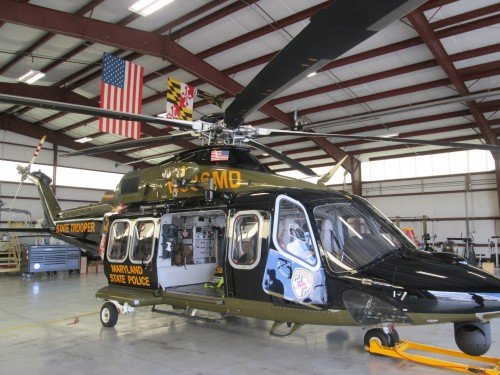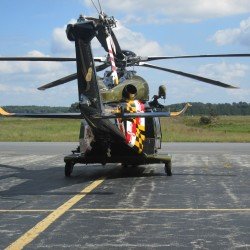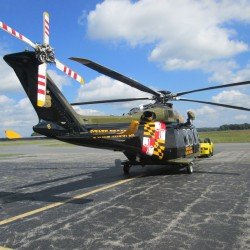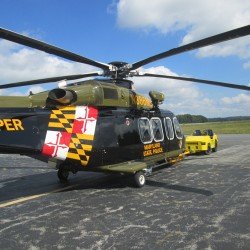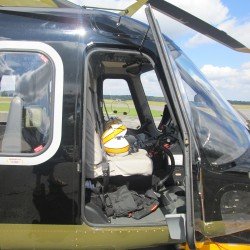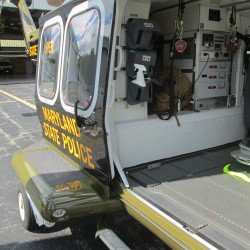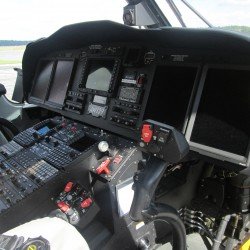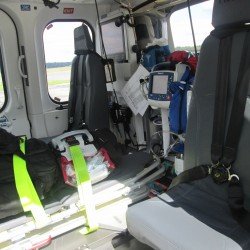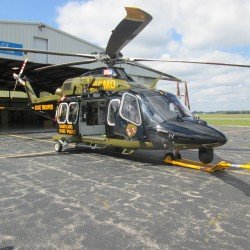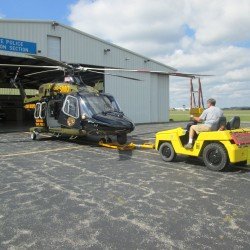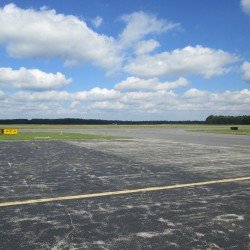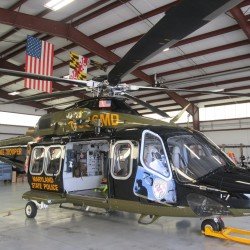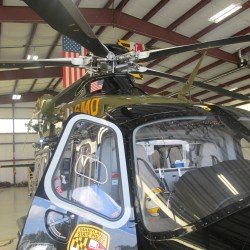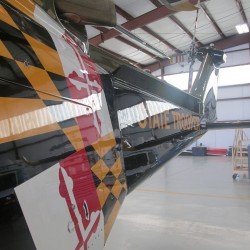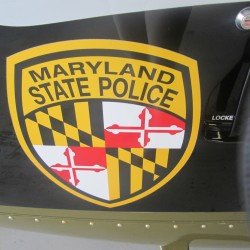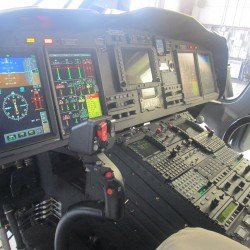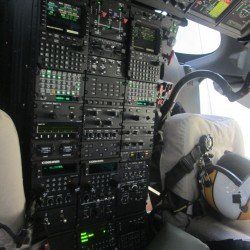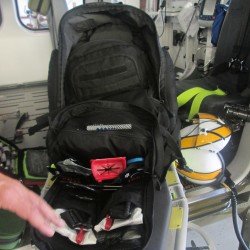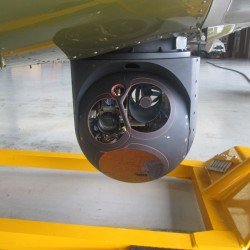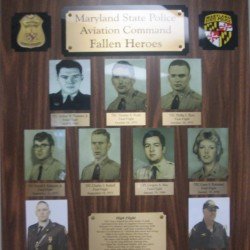We all stop and look as the ambulance rushes past and we all turn our heads to the sky when police helicopters fly high above, always wondering what the emergency is but rarely giving thought to the men and women behind the scenes who are making rescues and saves happen day in and day out. We were fortunate enough to get a tour of the Maryland State Police Aviation Command, Trooper 4, this week – an experience that has left us both humbled and grateful for the state-of-the art operations that are in affect 24 hours a day to serve and protect the Lower Eastern Shore of Maryland.
We met with Sergeant Michael Mann in the trooper hangar in Salisbury and were immediately in awe of the helicopter situated before us. Trooper 4 is a 24-hour a day operation based out of Salisbury that is primarily charged with servicing the lower four counties of Maryland – Wicomico, Worcester, Dorchester and Somerset – as well as operations in lower Delaware and the Eastern Shore of Virginia. While one might assume that the Trooper 4 aviation team is tasked solely with medevac missions, the team actually responds to several hundred flight requests per year, including medevacs, search and rescue missions, law enforcement missions, natural resource missions, and disaster assessment. The team is comprised of five pilots and five paramedics, with each flight carrying two pilots and two trooper paramedics. A ‘typical’ day can vary, with low-activity days juxtaposed with higher-activity days where the team could be flying round-trip to Baltimore three or four times. If this is starting to sound like the trailer for a high-intensity action movie, well, it sure felt like it for us as we toured the chopper and chatted with the crew.
“This really is the most advanced piece of equipment out there,” Mann said as he showed us the AW-139 helicopter. The equipment and the aviation command have certainly come a long way over the past 40 years. Mann explained that Dr. R Adams Crowley is considered the pioneer in shock trauma treatment, starting the University of Maryland Shock Trauma unit in the 1960s after discovering what would later be defined as the ‘shock trauma’ that people endure immediately following a traumatic accident or injury. Dr. Crowley began researching ways to save more patients’ lives during periods of shock, eventually partnering with the Maryland State Police by providing them with a helicopter to bring more patients to the Shock Trauma Unit. Within its first year, the Shock Trauma Center saw 150 patients. “People started to realize that the University Hospital was saving people that in the past would have been written off as a too far gone,” explained Mann.
Since then, the Aviation Command in Maryland has grown significantly. “Now there are seven bases across the state to provide equal access to all Marylanders” said Mann, explaining that not all states have such all-encompassing coverage. For example, while Maryland provides medevac helicopter service free of charge to patients, other states have medevac aircraft that are independently owned or contracted to hospitals. “In almost every other state it’s sporadic coverage and the rural areas suffer,”
said Mann, adding that in the past 42 years in Maryland, nearly 140,000 patients have been aided at no cost to that patient. “Because we took that approach, Maryland has always been the leader in medevac service.”
Maryland is also at the forefront of medevac service thanks to the recent purchase of the state-of-the-art aircrafts that are now being used. “This is the most technologically advanced, capable aircraft possible,” said Mann. “We are able to take several hours off of transport times.” This is particularly beneficial to rural areas where longer ambulance rides are a matter of life and death. Mann explained that the “golden hour” is that crucial hour of time that responders have to get patients to definitive care in order to revert the shock process. The helicopter travels at 160 mph and can make it from Ocean City to John’s Hopkins in Baltimore in just 45 minutes or from Ocean City to PRMC in Salisbury in 12 minutes.
Medevac calls make up 80 percent of activity for Trooper 4, with calls varying from hunting accidents to drowning victims. Mann explained that for their particular division, the year and season affect the type of accidents they see. For example, summertime brings a spike in accidents in Ocean City, while hunting season yields different types of situations.
When Trooper 4 receives a medevac call, the goal is to be airborne within 7 minutes. The pilots must be prepared for a variety of weather conditions and locations, explained Mann. “We’re expecting them, 24-hours a day, at any given moment, to be prepared to go to some place they’ve likely never been before and land.” It’s not until the trooper paramedics arrive at the scene that pilots can get a clear depiction of where they will be flying to next (i.e. which hospital and location). Turnaround time also varies, as it is not always feasible to extract a patient from an accident or relocate them right away. Once the patient is taken to the hospital however, it’s back to response mode. “As soon as we leave the hospital, we’re ready for the next call,” said Mann.
While medevac is the most prevalent activity for Trooper 4, there are also search and rescue missions, law enforcement missions, natural resource missions, and disaster assessment. As a result, the new helicopters and the equipment are designed to be fully configurable and adaptable to the demands of the situation at hand. “At any given moment, we can switch to search and rescue mode or law enforcement mode,” said Mann. In fact, oftentimes a call can end up transitioning mid-trip – i.e. a high speed chase that ends in an accident will call for the team to transition between law enforcement and medevac. Other typical calls can include searching for suspects, capsized boats, or missing children, a feat that has been improved with the addition of the new technology. The camera on the tip of the helicopter can hone in on people from miles away. The camera is also GPS enabled so the team is then able to pinpoint the exact location and arrive more quickly.
The training process for joining the team is intensive for both the pilots and the trooper paramedics. Pilots are required to have logged a minimum of 2000 hours of flight time, including experience flying with night vision goggles. Paramedics also undergo intense training and experience before joining the team.
For more information on Trooper 4 or to follow their progress and activity, visit and ‘like’ their Facebook page!






